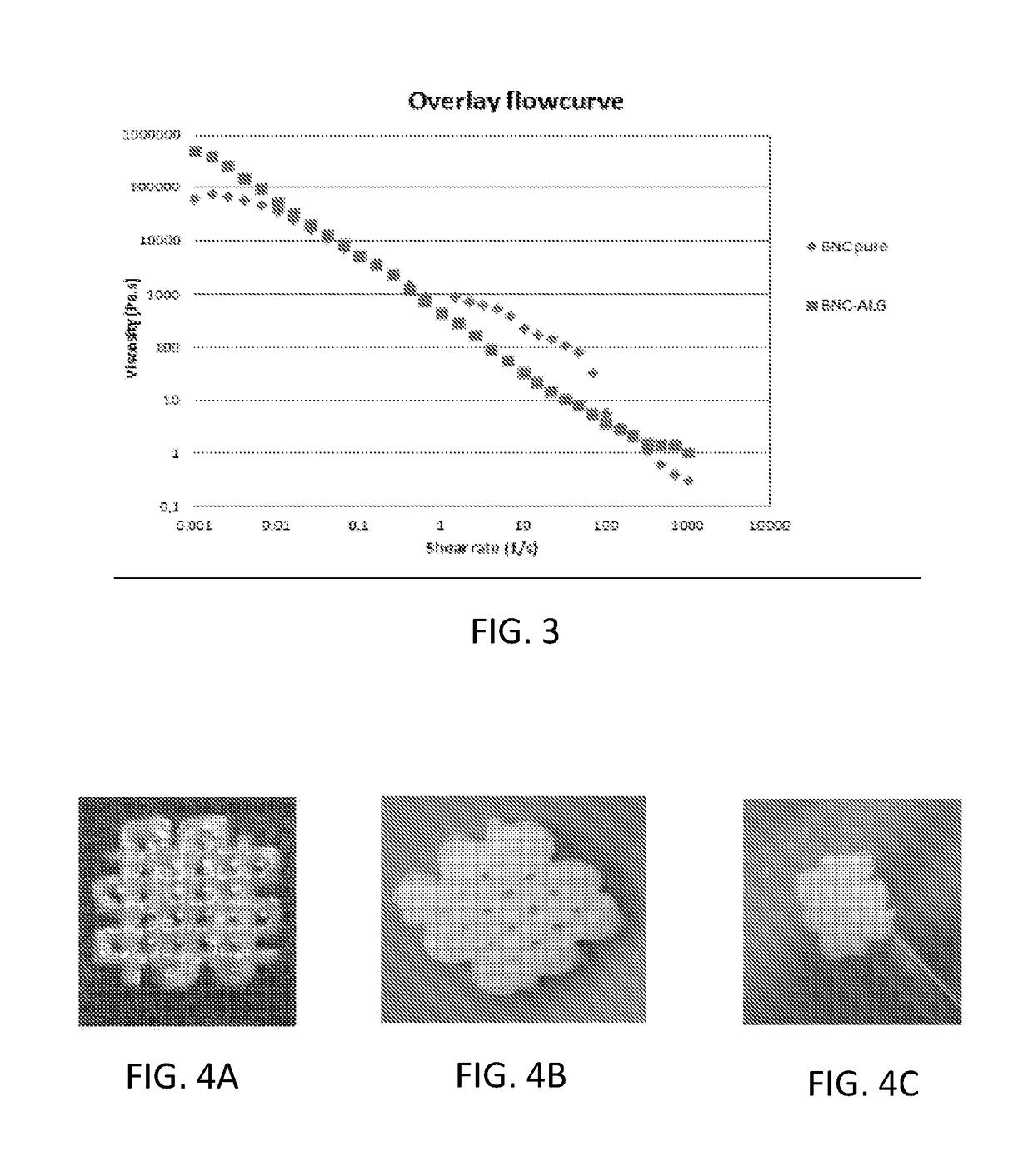Cellulose nanofibrillar bioink for 3D bioprinting for cell culturing, tissue engineering and regenerative medicine applications
a bioink and cellulose nanotechnology, applied in the field of bioinks, can solve the problems of shortening the number of organs needed, affecting the success rate of regenerative medicine, and often fast degradation of polymers, and achieve good viability
- Summary
- Abstract
- Description
- Claims
- Application Information
AI Technical Summary
Benefits of technology
Problems solved by technology
Method used
Image
Examples
example 1
on of Bacterial Cellulose (BC) Bioink and 3D Bioprinting
[0042]Tray bioreactors were inoculated with Gluconacetobacter xylinus ATCC® 700178. A suspension of 4×106 bacteria per ml and 25 ml of sterile culture media (described below) was added to each tray. The controlled volumes of sterilized media were added at each 6 hour increment to the top of the tray in such a manner that bacteria cultivation was preferably not disturbed. For example, the preferential addition is to use microspray, where media is added with a low pressure spray, mist, sprinkle or drip. The amount of the added media is calculated to be equivalent at least to an amount expected to be consumed by the bacteria during a 6 hour time period. The composition of the medium can be varied in order to control production rate of cellulose and network density. The trays were placed in a bacteriology cabinet and the bacteria were allowed to grow under these semi-dynamic conditions for 7 days at 30° C. The bacteria were removed...
example 2
on of Bioink Based on Wood Derived Nanocellulose and 3D Bioprinting with Human Chondrocytes
[0044]Cellulose nanofibrils (NFC) dispersion produced by mechanical refinement and enzymatic treatment was used as raw material for bioink preparation. The charge density of the NFC was determined to be 24 μeq / g. The NFC dispersion was purified using ultrafiltration followed by diafiltration with pyrogen free water. The NFC dispersion was further homogenized using Ultra turrax homogenizer and the concentration was brought to 2.5% by centrifugation (JOUAN CR 3i multifunction, Thermo Scientific) and removal of excess supernatant. The centrifugation was carried out at 4000 rpm for 10-20 minutes until the desired amount of supernatant was reached. The concentrated NFC was mixed intensely by stirring with a spatula for 10 minutes and autoclaved (Varioklav Steam Sterilizer 135T, Thermo Scientific) at liquid setting, 120° C. for 30 minutes. Alternative sterilization procedure was evaluated using elec...
example 3
of Support Using Nanocellulose Bioink
[0045]In order to evaluate the ability of using nanocellulose bioink as support for complex structures which could be produced with other materials such as collagen or extracellular matrix the following experiment was performed. Cellulose nanofibrillated ink was formulated with higher solid content (above 2.5%) to provide extremely high viscosity. The inner tubular structure for aorta or trachea was printed using cellulose bioink and then the outer tubular structure was printed with cellulose bioink. After each 500 micrometers the collagen was printed with another printing head between the two circles. The collagen ink, Bioink from regenHU was used and crosslinked using UV. This process continued until a desired length of tube was achieved. The cellulose bioink was not crosslinked and thus could be easily removed after printing process. This procedure was then evaluated to print with extracellular matrix which came from decellularized aorta. The ...
PUM
| Property | Measurement | Unit |
|---|---|---|
| width | aaaaa | aaaaa |
| length | aaaaa | aaaaa |
| width | aaaaa | aaaaa |
Abstract
Description
Claims
Application Information
 Login to View More
Login to View More - R&D
- Intellectual Property
- Life Sciences
- Materials
- Tech Scout
- Unparalleled Data Quality
- Higher Quality Content
- 60% Fewer Hallucinations
Browse by: Latest US Patents, China's latest patents, Technical Efficacy Thesaurus, Application Domain, Technology Topic, Popular Technical Reports.
© 2025 PatSnap. All rights reserved.Legal|Privacy policy|Modern Slavery Act Transparency Statement|Sitemap|About US| Contact US: help@patsnap.com



